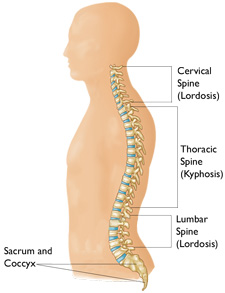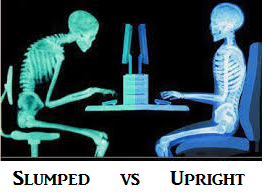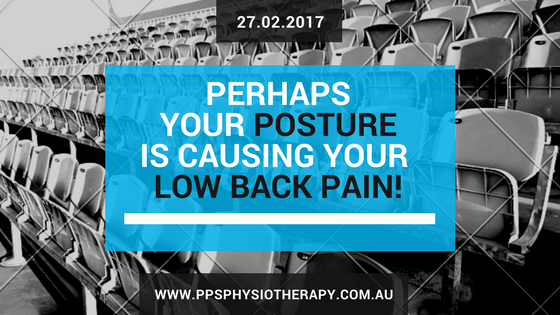February, Monday 27th 2017 by Grant Burton Master of Physiotherapy; B.Ex.Sci
Has your lower back ever been sore while you’re sitting in your office chair at work?
Has your lower back ever been sore while you’re sitting on your super comfy couch at home whilst watching TV?
Have you ever had lower back pain after a day of vacuuming your house, making your bed, or even doing some of the weekly gardening?
If you answered yes to any of the above questions, you may be interested to know that YOUR POSTURE can affect the amount of stress that goes through your lower back during these simple activities of daily living.
Placing stress on the spine
Our spines have natural curves that make up an ideal posture. To put simply the lower back (lumbar spine) and neck (cervical spine) have an inward curve and the mid back (thoracic spine/between the shoulder blades) has a natural outward curve (see photo to the right)
 When we perform movements (i.e housework) or sit & stand with poor/bad posture, particularly for prolonged periods of time, it can place increased stress and strain on our spines.
When we perform movements (i.e housework) or sit & stand with poor/bad posture, particularly for prolonged periods of time, it can place increased stress and strain on our spines.
As a general rule of thumb, when you maintain a neutral spinal position with the lumbar spine maintaining its natural inward/lordotic curved position, there will be less stress going through the lower back.
If for some reason you can’t maintain correct lower back posture, it may cause potential risk to some of the painful sensitive structures in your lower back. One of the structures that can be stressed in the low back is the intervertebral disc. Our overall body posture and low back position can affect the amount of pressure that actually goes through the disc as we perform different activities throughout the day.

For example, when we sit with a poor slumped posture, 100 percent more pressure goes through our low back discs compared to when we sit with an upright posture and are able to maintain the natural inward curve of the low back (see picture above) (1). Similarly, when we stand with a slumped posture, 125 percent more pressure goes through our low back discs compared to when we stand with an upright posture (1). What’s more, when standing and lifting a weight with a slumped posture, 250 percent more pressure goes through our low backs compared to when we lift a weighted object with a more upright posture (1).
These are all reasons why it is super important to pay attention to your posture at all times. So what can you do about it you ask? Read on….
Posture Tips
Below are a few tips to help you along the way to improving your posture
- When sitting down, make sure your shoulders are in line with your hips and you have a slight inward curve in your lower back.
- Try rolling up a small towel and placing it behind your back to help maintain the normal curve of your low back.
- Before you sit down, make sure your sit bones (bony area in the bum cheeks) are all the way towards the back of the seat/chair, this will insure you stay more upright and hopefully cue you to maintain this upright position rather than rounding out that lower back of yours.
- DON’T SIT TO LONG. No matter how good your sitting posture is, there is no better substitute for improving poor sitting postural habits, then moving out of your sitting position for a period of time (we recommend our patients try getting up and moving every 30mins to an hour – to help avoid the increase stresses in the lower back that come with prolonged sitting).
- When you are standing still or standing with a weighted object in your hand, make sure your shoulders are in line with your hips and your hips are in line with your knees and ankles. Also make sure that you are bracing your middle section (i.e core) at all times during the lifting movement.
- Be sure to maintain the inward curve of your low back by avoiding slouching over.
Final thoughts – we treat patients with postural related back pain issues on a daily basis, it is one of the most common complaints we see. So, If you are concerned about your posture or are experiencing low back pain, make sure to give our clinic – PPS physiotherapy Carlingford/Kellyville a call on 9871-2022 or 9672-6752, respectively, to schedule a consultation with one of our physiotherapists who will be happy to teach you how to maintain good posture in order to keep your back healthy!
See you in the clinic!!!
1. Wilke HJ, Neef P, Caimi M, Hoogland T, Claes LE. New In Vivo Measurements of Pressures in the Intervertebral Disc in Daily Life. Spine. 1999;24:755-762.

